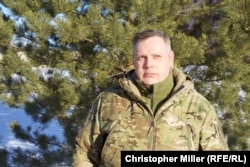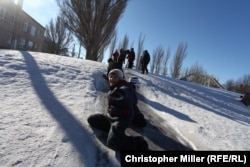NOVOLUHANSKE, Ukraine -- The way Ukrainian commander Vyacheslav "Eagle-Owl" Vlasenko described it, his troops snuck into this rustic town of 4,000 people in broad daylight and took it -- and a valuable pig farm -- without firing a shot.
Concealed in trucks that looked like those used by the pig farm, the troops' advance into Nuvoluhanske -- which had been part of the gray zone, a ravaged no-man's land between the warring sides -- took their Russia-backed separatist foes by surprise.
"We used civilian trucks and a sort of maskirovka," Vlasenko, clad in fatigues, told RFE/RL at the command-and-control center of the Ukrainian Army's 46th battalion in nearby Zaitseve on January 23. It was a reference to a deception tactic widely credited to Russian military planners and employed by the Kremlin when it seized Ukraine's Crimean Peninsula in 2014.
"It was 1 p.m." Vlasenko said. "They figured out what had happened at 8:45 p.m. and began firing artillery, striking near our defensive positions on the east side of the pig farm."
Mounting Discontent
Frustrated by the stalemate in this 33-month war of attrition, concerned that Western support is waning, and sensing that U.S. President Donald Trump could cut Kyiv out of any peace negotiations as he tries to improve fraught relations with Moscow, Ukrainian forces anxious to show their newfound strength have gone on what many here are calling a "creeping offensive."
Observers say the Ukrainians appear to be trying to create new facts on the ground, while officials and commanders insist they are fighting to stop the flow of contraband into separatist-controlled territories and fending off attempts by separatist groups that call themselves the Donetsk and Luhansk "people's republics" to seize more territory.
Whatever the case, since mid-December Ukraine's armed forces have edged farther into parts of the gray zone in or near the war-worn cities of Avdiivka, Debaltseve, Dokuchaievsk, Horlivka, and Mariupol, shrinking the space between them and the separatist fighters.
In doing so, the pro-Kyiv troops have sparked bloody clashes with their enemy, which has reportedly made advances of its own -- or tried to -- in recent weeks.
The Ukrainian military reported that 17 of its soldiers were killed in the December battles. At least 16 more have been killed in fighting this month, including seven on January 29-30. There are no reliable figures for the separatist side.
In all, Europe's only active war has claimed the lives of more than 9,750 people and displaced some 1.7 million more since it began in April 2014, according to the United Nations.
And all signs point to the conflict getting worse before it gets better.
Fears Of Escalation
Stalker, the nom de guerre of a commanding officer who declined to give his full name, showed RFE/RL through the 46th battalion's labyrinth of freshly dug trenches that keep the soldiers safe from artillery shells and sheltered from the biting winter.
Within the stuffy confines of a bunker housing weapons, ammunition, rations, and half a dozen men and at least one woman, soldiers warmed themselves by a field stove, checked social media on their smartphones, and prepared borsch during a rare lull in fighting.
They were the lucky ones. Three of their fellow troops had been wounded and evacuated since taking up the position, Stalker said.
All that divides the two sides here is 350 meters and a cemetery smack in the middle of a snow-covered field -- a dark symbol that is not lost on the fighters.
Soon, from a road over the hill came a convoy of European monitors who had been critical of the advances. They were there to inspect the new Novoluhanske positions.
"The direct result of forward moves is escalation in tension, which often turns to violence," Alexander Hug, the principal deputy chief monitor of the Organization for Security and Cooperation in Europe's Special Monitoring Mission (OSCE SMM) to Ukraine, had told RFE/RL prior to his visit.
Hug said the soldiers had recently become more brazen. For much of the conflict, they have played a game of hide-and-seek with the OSCE, concealing their weapons from the international monitors' scrutinizing eyes.
But, Hug said, they now position large-caliber artillery, including towed howitzers, main battle tanks, and multiple-launch rocket systems banned under the Minsk deal "in the open with impunity."
Caught In The Cross Fire
As the two sides push closer to each other, they risk not only their own lives but those of civilians.
On January 27, Hug reported five civilians had been killed this month alone as a result of the clashes. He said 19 were killed in all of 2016, a year in which the OSCE recorded more than 300,000 cease-fire violations.
At an elementary school in Novoluhanske a few hundred meters from the 46th battalion's new trenches, teacher Lyudmila Alekseyevna told RFE/RL while watching her fourth-graders slide down an icy mound that townspeople feel like "death is knocking on our doors."
"We are ready for peace to return to us," she said, adding that she did not know why the military had come to Novoluhanske.
Combating Lawlessness
Pavlo Zhebrivskyy, the governor of the Donetsk region, told RFE/RL at his office in Kramatorsk that the Novoluhanske move to where there had been no police presence was necessary to stop smuggling.
With supplies limited in the conflict zone, a lucrative black market has flourished. Kyiv estimates traffickers make millions sneaking coal, fuel, food, and more across the front line.
In the past week, nationalist activists have blocked "indefinitely" a railway line they claim is used to trade illegal contraband with the separatists.
"There was no law enforcement to stop criminal activity, [including] the illegal smuggling of Ukrainian goods...of pig meat," said commander Vlasenko.
Novoluhanske's pig farm houses some 93,000 swine and produces up to 20 tons of meat per day, much of which soldiers claimed and journalists reported had been trafficked into separatist-controlled territory.
Zhebrivskyy said that "98 percent of smuggling" around Novoluhanske ceased after the 46th battalion's arrival.
Bumpy Road To Peace
Hug said battlefield advances by both sides make implementing the 2015 peace deal, known as the Minsk agreement, "more difficult."
Ukrainian authorities insist their moves do not endanger the peace process and are not in violation of the Minsk deal because they did not cross in separatist-controlled territory.
"According to the Minsk agreement, there is a clear delineation of the contact line, and there were absolutely no violations by Ukraine in terms of the contact line, but there have been significant violations on the other side's part," Ukrainian Defense Minister Stepan Poltorak told RFE/RL in Kyiv on January 21.
Put more simply, Stalker said, "It's our Ukrainian land. How can it ever be a violation?"
Russians In Waiting
There is also a haunting prospect of Ukraine's creeping offensive: the risk of provoking a military response from Russia, as Kyiv and Western officials say previous advances did.
Ukraine suffered two devastating defeats -- in Ilovaisk in August 2014 and in Debaltseve in February 2015 -- that left hundreds of troops dead after Russia-backed forces encircled them and pounded their positions with heavy artillery. The battle changed the Ukrainians' calculus and gave the separatist side the clear upper hand.
Poltorak noted that Russia has since constructed several military bases and camps close to Ukraine's border, which allows Russia to deploy thousands of its troops "within a matter of hours."
Moreover, he claimed, 5,000 regular soldiers of the Russian armed forces are already on separatist-held territory, along with 40,000 Russian nationals fighting in separatist militias.
In addition to personnel, Poltorak said, Russia has deployed to eastern Ukraine "more than 600 main battle tanks, more than 1,300 armored vehicles, more than 700 pieces of artillery, and more than 450 multiple-launch rocket systems."
Russia denies sponsoring the separatists or deploying its forces to Ukrainian territory, despite overwhelming evidence of both.
New Strength?
Ukraine's army appears to feel emboldened almost three years after the start of the fighting, having undergone a crash course in warfare and modernized its military -- bold enough for some to say the occupied areas of eastern Ukraine could be "liberated" by the end of 2017.
After increasing its defense budget to about $6 billion, Ukraine created a standing army of 250,000 soldiers -- up from only 5,000 to 6,000 combat-ready troops in April 2014, Poltorak said. That makes it among the largest armies in Europe.
Meanwhile, its state arms maker has pumped out new military materiel, including an unmanned fighting vehicle, and it hopes to manufacture a new main battle tank to rival one made by Russia.
Last month, Ukraine tested a new "high-precision" missile for Smerch multiple-launch rocket systems that has a range of 60 kilometers.
Peace Through Power
While leaders in Kyiv and Moscow say publicly the only way to solve the current conflict is through political means, neither has shown a willingness to do so, Hug said.
Asked about the Ukrainian military's recent advances and weapons testing, Poltorak said a political solution is "only possible if Ukraine will have a powerful army." Otherwise, he said, its adversaries won't take it seriously.
Back in Novoluhanske, the 46th battalion's Vlasenko boasted that if politicians couldn't bring an end to the war, his soldiers could recapture the occupied territories by force "and be at the border with Russia in around six months."
But he added a caveat: "It would cost many civilian lives."















